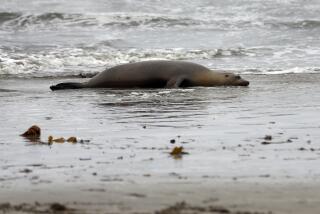A YEAR LATER . . . : Bite Taken Out of Fear for Surfers : Hawaii’s Shark Hunt Kills 58, but Caution Isn’t Being Thrown to the Wind Quite Yet
- Share via
It was a little more than a year ago when Rick Gruzinsky, a construction worker from suburban Honolulu, was sitting on his surfboard at dawn at an offshore reef near Laniakea on Oahu’s North Shore. His friend had caught a small wave in. Gruzinsky was alone.
Or so he thought.
Lurking nearby in the blue-green sea was a 14-foot tiger shark. It swirled beneath Gruzinsky, then crashed the surface and clamped down on the front of his surfboard, shaking its head and snapping off a large chunk. Gruzinsky vividly remembers seeing the chunk stuck in the shark’s open mouth as the startled surfer climbed back onto his broken board and raced back to shore.
Reached the other day at his home in Hawaii Kai, Gruzinsky, 28, said he has not quit surfing, but he can’t shake the memory of that attack on Oct. 22, 1992.
Nor can anyone else in and even beyond the surfing community on Oahu.
Gruzinsky’s was only the first of three confirmed attacks within a period of two months, including the fatal attack at Keaau Beach Park on bodyboarder Aaron Romento, who bled to death after being bitten on the leg shortly after reaching shore screaming for help. And then there was Gary Chun, who like Gruzinsky saw his board snatched and bitten by a large shark while Chun was waiting for a wave near Laniakea. He escaped with minor injuries.
Subsequent sightings and alleged sightings were reported by the dozens last winter as the situation bordered on hysteria, prompting a shark scare of unprecedented proportions, and the first comprehensive shark hunts since the early 1970s.
State shark experts, whose policy is to hunt sharks only after an attack or if it is determined that a genuine threat exists, were not the only ones involved. Surfers, fishermen, divers and even prominent businessmen concerned about the welfare of their children went to sea to catch and kill as many sharks as they could get their hooks into. The shark fishing effort continued into the summer.
“According to my records, 58 large tiger sharks were taken around Oahu, so I think we may have made a substantial dent in the population,” said John Naughton, a National Marine Fisheries Service biologist and prominent member of the recently disbanded state shark task force. “Obviously there are still some around . . . but one thing, it seems to have really reduced the number of attacks around Oahu.”
Indeed, a relative calm has prevailed this winter as the only “shredding” on the North Shore of Oahu is being done by surfers, who travel to the island from all over the world each winter to ride the large waves generated by Arctic storms. There has not been a single confirmed attack.
But shark experts, none of whom knows how many tiger sharks there are or whether they migrate from island to island, are quick to point out that this might only be a coincidence. They are certain of only one thing: At least 58 tiger sharks eight feet or longer were removed from the shores of Oahu.
“We don’t know if they were 58 out of a population of 59 or 58 out of a population of 58,000,” said Dr. Kim Holland, a shark expert with Hawaii’s Department of Land and Natural Resources.
Some, such as Holland, believe that surfers--the primary victims of shark attacks because they surf well offshore and often at dusk and dawn, when tiger sharks are beginning and ending their nighttime feed at the reefs--might have actually been lulled into a false sense of security because of the hunts.
But they will agree that some good has come of the attacks and subsequent scare. Surfers are more aware of their surroundings and for the most part are using better judgment, not paddling out near the mouths of rivers, where runoff carries dead animals and other debris that sharks feed on, and by not paddling out alone at dusk and dawn, particularly in murky waters, where tiger sharks prefer to hunt.
A surfer suffered serious leg wounds after being attacked by a tiger shark last October off Kauai while surfing in murky water near the mouth of the Wailua River.
“The attacks are still in the minds of people,” said George Downing, 63, a Honolulu surf shop owner who became legendary in surfing circles in the 1950s and ‘60s for his big-wave riding on the North Shore. “One of the concerns now is to stop certain things from taking place, and I think more attention is being given to such areas by the lifeguard service. There’s more awareness.”
Said Gruzinsky: “People are a lot more aware. They even talk about it on the (telephonic) surf report. The other day after a lot of rain and runoff, it was the first I’d ever heard, on the surf line they said, ‘Watch out for the guys in the gray suits because of the muddy water.’ ”
In large part because of the attacks and the attention they received, the state--which was urged by surfers after each attack to do more hunting and by conservationists after each hunt to leave the sharks alone--decided to make a serious attempt to learn more about “the guys in the gray suits,” which were patrolling Hawaii’s offshore reefs long before anyone thought of riding the waves that break over them.
“Our goal is to determine what are typical ranges and movements of tiger sharks around heavily populated coastlines,” said Holland, who directs a new tagging program in which sonic devices are used to track the creatures’ movements. “The idea being that if you know more about what the animal is doing, then you can more rationally evaluate management options.”
This approach seems to be keeping attacks to a minimum while at the same time saving the tiger shark from random hunts. Such hunts could adversely affect Hawaii’s coastal marine ecosystem, in which tiger sharks play a vital role by keeping the number of smaller reef sharks and other animals in check.
The state’s tagging program has been slow to develop, however.
Since last fall, only three tiger sharks have been tracked, and merely for short periods of time. The results were somewhat surprising in that all three sharks traveled across the channel from Oahu to Molokai. The popular belief was that tiger sharks are predominantly coastal animals that prefer fairly shallow water.
“They traveled about 29 miles from where they were released, but that to me is not surprising,” Holland said. “What surprises me is that it wasn’t along the shore. It was straight out to sea and hang left. And that brought them up along a shallow area off the coast of Molokai.”
The first two sharks--a 7-foot immature male and a 12-foot mature female--were tracked late last fall for 24 and 30 hours, respectively. One of the sharks dived 1,000 feet and was still far from the bottom, which was also surprising because tiger sharks in coastal areas generally stay close to the bottom.
Unfortunately, both transmitters failed, and the knowledge gained from such a small sample is basically useless. Stress, too, may have been a factor in the sharks’ behavior immediately after being tagged. A longer tracking period would have been more helpful.
A third shark was tagged and tracked recently, but for only about six hours before the transmitter’s battery failed. Then the engine on the boat used to track the animals failed.
Holland acknowledges that the results of the program thus far are “not very conclusive,” but he said money has been raised to fix the boat and that the DLNR remains optimistic that many of the mysteries of the tiger shark can be solved, given time.
Surfers, meanwhile, still are watching the horizon for more than the next set of waves, but are more comfortable knowing there are fewer sharks.
More to Read
Sign up for Essential California
The most important California stories and recommendations in your inbox every morning.
You may occasionally receive promotional content from the Los Angeles Times.










